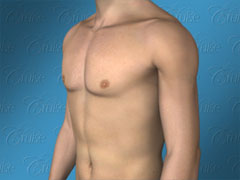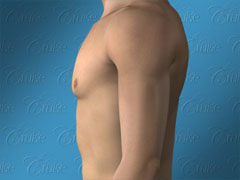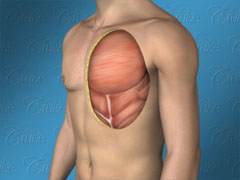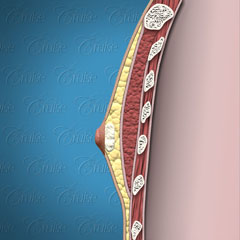Gynecomastia Ideal Male Chest
Gynecomastia Ideal Male Chest
Ideal Male Chest
Before we describe the various types of gynecomastia it is critical to define what the ideal male chest looks like so we are clear on what it is we wish to accomplish. It is important to understand that not every man can have the “ideal chest”. Conditions such as advancing age, excessive body weight, poor skin elasticity, and unfavorable anatomy can affect what is obtainable.
- Overview of Gynecomastia
- Causes of Gynecomastia
- Ideal male chest
- Joseph T Cruise, MD’s Gynecomastia Philosophy
- 7 Types of Gynecomastia
- 1-Puffy nipple. Breast tissue outside of areola
- 2-Chest angle less than 45 °
- 3-Chest angle 45-60° Mild breast sag
- 4-Chest angle 60-90° Moderate breast sag
- 5-Chest angle greater than 90° Significant sag
- 6-Top of areola is above chest fold. Severe sag
- 7-Top of areola is below chest fold. Extreme sag
- Are You a Good Candidate?
- Benefits of Male Breast Reduction
- Components of Gynecomastia
- Classic Gynecomastia
- Puffy Nipples
- Fatty Gyecomastia
- Saggy Gynecomastia
- Breast Roll
- Prior to Male Breast Reduction
- Male Breast Reduction Anesthesia
- After the Male Breast Reduction
- Recovery from Male Breast Reduction
- Possible Complications
- Gynecomastia Cost and Financing
- Gynecomastia Words to Know
- Gynecomastia Before and After Pictures
 |
 |
Ideal Chest – Notice the horizontal orientation of breast tissue showing the outline of the underlying pectorals major muscle.
As you can see, the ideal chest is not flat. It has a defined contour and natural chest fold separating the chest from the abdomen. The ideal chest fold is predominately horizontal. However, it begins to round out with increasing degrees of gynecomastia.
 Ideal Chest (Profile view) – The ideal chest is not flat. Instead, it has a defined masculine contour. |
On the ideal chest, the nipple is typically 5-6 cm above the chest fold and faces forward. The areola is flush with the surrounding skin. However, with certain types of gynecomastia, the areola protrudes forward creating a “puffy nipple.”
 Ideal Chest – Above cut out view demonstrates normal subcutaneous fat under the skin and the underlying pectorals major muscle |
If you look at the margins of this cut out, you will see there is an approximately ½ inch of fat underneath even the ideal chest. This is why removing all the fat is not a good idea. Additionally, notice the contour of the pectorals major muscle and how it corresponds to the chest fold.
| The ideal male chest has some breast tissue located directly below the areola. You can feel it by squeezing the tissue under the areola. It is firm, glandular tissue unlike soft, fatty tissue. This amount of breast tissue is normal. Gynecomastia is an excess of this normal breast tissue |
 Ideal Chest – Above slice view |


